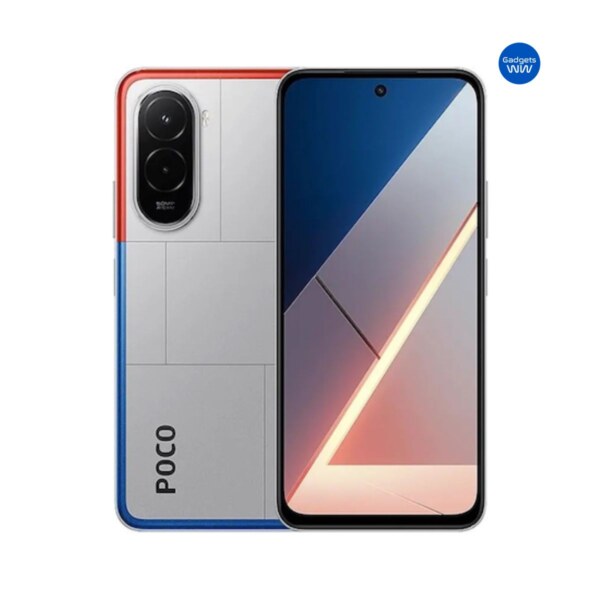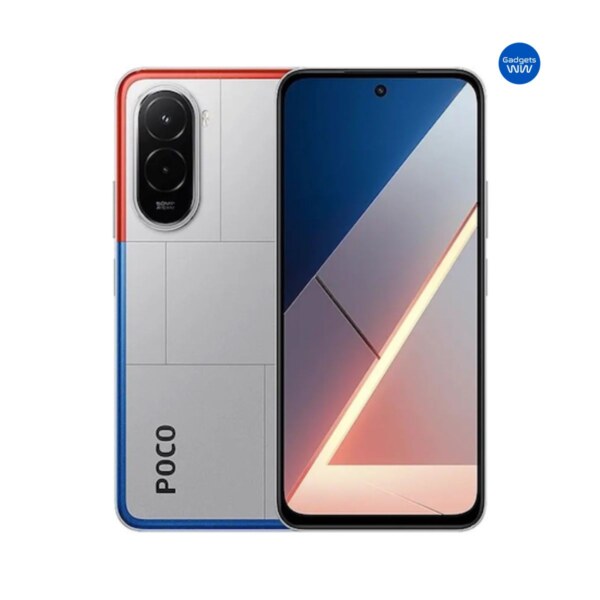Xiaomi Poco M7 Plus







-
Display: 6.9" (1080x2340 pixels)
-
Processor: Snapdragon 6s Gen 3
-
Rear Camera: 50MP
-
RAM: 4GB / 6GB /8GB
-
Storage: 128GB / microSDXC
-
OS: Android 15, up to 2 major upgrades, HyperOS 2
-
Battery: Si/C Li-Ion 7000 mAh
Introduction
The smartphone market in 2025 is more competitive than ever, and Xiaomi’s sub-brand POCO continues to play a major role in defining what consumers can expect from mid-range devices. This year, the brand has unveiled its latest masterpiece, the Poco M7 Plus, a phone designed to deliver exceptional performance, a long-lasting battery, and a fluid display, all at a budget-friendly price.
The Poco M7 Plus is more than just another mid-range smartphone. It’s a statement from Xiaomi that great technology doesn’t have to come with a premium price tag. Whether you’re a gamer, a streamer, or a heavy multitasker, this phone is built to handle it all. In this comprehensive Poco M7 Plus review, we’ll explore every aspect, from design and performance to battery life, camera quality, and software, to see if it truly lives up to the hype.
Poco M7 Plus Release Date and Price
The Poco M7 Plus release date was set for mid-August 2025, and it immediately caught attention with its blend of high-end features and aggressive pricing. The Poco M7 Plus price starts around $150 (USD) globally, or approximately ₹13,999 in India, making it one of the most affordable smartphones offering 5G, a massive 7,000 mAh battery, and a 144 Hz display.
In markets like Nigeria, the Poco M7 Plus price in Naira starts at around ₦185,000, while in Europe it lands near €160. These prices make the Poco M7 Plus a strong contender for anyone looking for maximum value in 2025. It fits squarely in the affordable midrange category but packs specifications that challenge even some upper-tier devices.
Design and Display, A Modern Look with a Premium Feel
At first glance, the Poco M7 Plus looks bold and distinctive. The design language is sharp yet elegant, combining a matte-textured back panel with curved edges that make it comfortable to hold despite its size. The camera housing adopts POCO’s signature horizontal bar, giving the device a premium aesthetic.
The phone features a large 6.9-inch Full HD+ display with a resolution of 2460×1080 pixels. What truly sets it apart is the 144 Hz refresh rate, which provides incredibly smooth motion and responsiveness whether you’re scrolling through apps, watching videos, or playing games. This is a rare feature at this price point, one that even some flagship phones struggle to match.
Brightness peaks at around 850 nits, ensuring solid visibility under direct sunlight, while the display’s color reproduction is vibrant and accurate. Xiaomi uses Corning Gorilla Glass 3 for protection, keeping the screen safe from scratches and minor drops. Despite its size, the phone feels sturdy and well-built, with a premium touch not often found in budget phones.
The Poco M7 Plus comes in striking color options like Aqua Blue, Carbon Black, and Chrome Silver, each appealing to different styles of users. Another highlight is its IP64 water and dust resistance, offering an extra layer of durability for outdoor or everyday use.
Performance, Midrange Powerhouse with Snapdragon 6s Gen 3
When it comes to performance, the Poco M7 Plus delivers more than expected for its price. It is powered by the Qualcomm Snapdragon 6s Gen 3 chipset, a 6nm octa-core processor designed for efficient multitasking and 5G connectivity. The CPU combines two Cortex-A78 performance cores clocked at 2.3 GHz and six Cortex-A55 efficiency cores at 2.0 GHz, paired with the Adreno 619 GPU for improved gaming performance.
The phone comes in two memory configurations: 6 GB RAM + 128 GB storage and 8 GB RAM + 128 GB storage, with support for up to 1 TB microSD expansion. It also includes virtual RAM expansion, allowing up to 8 GB of additional memory for smoother multitasking.
In day-to-day use, the Xiaomi Poco M7 Plus performance is excellent. Apps open quickly, background processes remain stable, and multitasking feels fluid. The device handles casual and moderate gaming effortlessly, titles like PUBG Mobile, Asphalt 9, and Call of Duty Mobile run smoothly with minimal frame drops. Even after extended gaming sessions, the phone manages heat well, thanks to its optimized cooling system and efficient processor.
This combination of performance and optimization makes the Poco M7 Plus ideal for users who demand power without paying flagship prices.
Battery Life, The Heart of the Poco M7 Plus
If there’s one feature that defines the Poco M7 Plus, it’s the battery. The phone comes with a massive 7,000 mAh silicon-carbon battery, a technology that enhances longevity and energy retention. Xiaomi claims the battery retains up to 80% of its capacity even after 1,600 charge cycles, roughly four years of use for an average user.
With this capacity, the Poco M7 Plus battery life easily lasts two full days under normal use. Heavy users can comfortably go through an entire day of gaming, streaming, and social media without needing to recharge. POCO estimates up to 144 hours of music playback, 24 hours of video playback, or 12 hours of continuous navigation, making it a true endurance king.
Charging is handled by a 33 W fast charger included in the box. While not the fastest in the market, it’s efficient enough to top up the massive battery in just over 90 minutes. The device also supports reverse wired charging at 18 W, allowing you to use it as a power bank for smaller devices like earphones or smartwatches, an extremely handy feature during travel or emergencies.
The combination of battery capacity, efficient chipset, and optimized software makes the Poco M7 Plus one of the best smartphones in 2025 for battery-conscious users.
Camera, Reliable for Everyday Photography
The Poco M7 Plus camera setup might not compete with flagship phones, but it holds its ground in the midrange segment. It sports a 50 MP primary sensor with an f/1.8 aperture, delivering crisp and colorful shots under good lighting. The secondary sensor assists with depth and macro photography, allowing for creative portrait and close-up shots.
The 8 MP front camera is decent for selfies and video calls. While low-light performance can introduce some noise, the AI processing does a good job at enhancing details and balancing exposure.
The camera app offers several modes such as:
- AI Scene Detection – automatically adjusts color and contrast
- Night Mode – brightens dark scenes without losing much detail
- Portrait Mode – adds adjustable background blur
- Pro Mode – for manual control over ISO, focus, and shutter speed
- AI Eraser – removes unwanted objects from photos
Video recording supports up to 1080p at 60 fps, providing smooth footage with natural colors. While optical stabilization is missing, the electronic stabilization performs reasonably well in everyday situations.
Overall, the Poco M7 Plus camera may not win photography awards, but for casual users, vloggers, and social media creators, it delivers impressive results for its category.
Software and User Experience
The Xiaomi Poco M7 Plus runs on Android 15, customized with POCO’s latest HyperOS interface. HyperOS is a significant improvement over MIUI, designed for better speed, security, and personalization. It’s lightweight, smooth, and includes several optimizations that enhance both battery performance and app response.
POCO promises two years of major Android updates and four years of security patches, ensuring the phone remains secure and up to date. The software also features a 48-month anti-lag commitment, meaning the system is optimized to resist performance slowdowns over time.
HyperOS brings a clean look with intuitive gestures, customizable themes, and smart features like Memory Expansion, Smart Battery Saver, and Dynamic Refresh Rate, which automatically adjusts the screen’s refresh rate to balance smoothness and efficiency.
For privacy-conscious users, POCO includes new security tools that control app permissions, data access, and background behavior. The overall interface is stable, responsive, and easy to navigate, even for first-time users.
Connectivity and Audio
The Poco M7 Plus supports dual 5G connectivity, ensuring faster data speeds and lower latency. It also includes Wi-Fi 6, Bluetooth 5.2, GPS, and NFC for contactless payments. The USB Type-C port supports fast data transfer and charging, though it’s worth noting that some variants might skip the 3.5 mm headphone jack.
Audio performance is clear, with a single bottom-firing speaker that produces adequate volume and clarity. While stereo speakers would have been a welcome addition, the sound profile is balanced enough for videos and music. The phone also supports Hi-Res Audio via wired or Bluetooth headphones.
Poco M7 Plus vs Rivals
When it comes to competition, the Poco M7 Plus vs rivals comparison is where it truly shines. In its price range, it goes up against devices like the Realme Narzo 80 Pro, Samsung Galaxy A16, and Infinix Zero 30 5G. Most competitors offer smaller batteries or slower displays, while the M7 Plus dominates with its 7,000 mAh capacity and 144 Hz refresh rate.
Compared to its own siblings, the Poco M7 Pro and Poco M7, the M7 Plus brings noticeable upgrades, including a better processor, improved water resistance, and a larger, smoother screen. It’s clear that Xiaomi positioned this model as the ultimate “plus” experience for those wanting flagship endurance on a budget.
Strengths and Weaknesses
Strengths:
- Massive 7,000 mAh battery with excellent endurance
- Smooth 144 Hz large display for gaming and media
- Reliable Snapdragon 6s Gen 3 processor
- IP64 dust and splash resistance
- Good daylight camera performance
- Android 15 with HyperOS and long-term updates
- Value-packed Poco M7 Plus price in 2025
Weaknesses:
- On the heavier side at 217 grams
- 33 W charging could be faster
- Basic secondary camera
- Lacks stereo speakers
- May not include a headphone jack on some variants
Despite these minor limitations, the Poco M7 Plus remains an exceptional package for its price, offering a combination of features that’s hard to beat in 2025.
Who Should Buy the Poco M7 Plus?
The Xiaomi Poco M7 Plus is ideal for users who prioritize performance, endurance, and value. If you are:
- A gamer seeking smooth visuals and stable performance
- A traveler needing long battery life on the go
- A student or professional relying on productivity and multitasking
- A content consumer who watches a lot of videos or streams daily
Then the Poco M7 Plus is built for you. It’s also an excellent choice for anyone upgrading from older 4G phones, as it offers a solid entry into the 5G era without breaking the bank.
Conclusion, The Perfect Balance of Power and Price
As we wrap up this Poco M7 Plus review, one thing is clear: Xiaomi has managed to strike the perfect balance between power, performance, and affordability. The combination of a 144 Hz display, Snapdragon 6s Gen 3 processor, and a 7,000 mAh battery makes the Poco M7 Plus a true standout in the 2025 midrange smartphone lineup.
The camera may not compete with flagships, and the charging speed could be faster, but for the price, it delivers everything that truly matters. It’s a phone that lasts long, runs smoothly, and looks premium, all without costing a fortune.
If you’re looking for a smartphone that gives you more for less, the Xiaomi Poco M7 Plus should definitely be at the top of your list in 2025.
Specs
LAUNCH
| Announced | 2025, August 13 |
| Availability | Available. Released 2025, August 19 |
NETWORK
| 2G Bands | GSM 850 / 900 / 1800 / 1900 |
| 3G Bands | HSDPA 850 / 900 / 2100 |
| 4G Bands | 1, 3, 5, 8, 20, 28, 40, 41 |
| 5G Bands | 1, 3, 5, 8, 20, 28, 40, 78 SA/NSA |
| Speed | HSPA, LTE, 5G |
| Technology | GSM / HSPA / LTE / 5G |
DESIGN
| Measurements | 168.5 x 80.5 x 8.4 mm (6.63 x 3.17 x 0.33 in) |
| Weight | 217 g (7.65 oz) |
| SIM | Nano-SIM + Nano-SIM IP64 dust tight and water resistant (water splashes) |
DISPLAY
| Type | IPS LCD, 144Hz, 700 nits (typ), 850 nits (HBM) |
| Size | 6.9 inches, 116.9 cm2 (~86.2% screen-to-body ratio) |
| Resolution | 1080 x 2340 pixels, 19.5:9 ratio (~374 ppi density) |
| Protection | Corning Gorilla Glass 3 |
PLATFORM
| OS | Android 15, up to 2 major Android upgrades, HyperOS 2 |
| Chipset | Qualcomm SM6375 Snapdragon 6s Gen 3 (6 nm) |
| CPU | Octa-core (2x2.3 GHz Cortex-A78 & 6x2.0 GHz Cortex-A55) |
| GPU | Adreno 619 |
MEMORY
| Card Slot | microSDXC (uses shared SIM slot) |
| Internal | 128GB 4GB RAM, 128GB 6GB RAM, 128GB 8GB RAM |
REAR CAMERA
| Dual | 50 MP, f/1.8, (wide), PDAF Auxiliary lens |
| Features | LED flash, HDR |
| Video | 1080p@30fps |
SELFIE CAMERA
| Single | 8 MP, f/2.0, (wide) |
| Features | HDR |
| Video | 1080p@30fps |
SOUND
| Loudspeaker | Yes |
| 3.5mm Jack | No |
COMMUNICATION
| WLAN | Wi-Fi 802.11 a/b/g/n/ac, dual-band |
| Bluetooth | 5.1, A2DP, LE |
| Positioning | GPS, GLONASS, GALILEO, BDS |
| NFC | Yes (market/region dependent) |
| Radio | No |
| Infrared Port | Yes |
| USB | USB Type-C 2.0 |
FEATURES
| Sensors | Fingerprint (side-mounted), accelerometer, compass Virtual proximity sensing |
BATTERY
| Kind | Si/C Li-Ion 7000 mAh |
| Charging | 33W wired 18W reverse wired |
OTHERS
| Colors | Chrome Silver, Aqua Blue, Carbon Black |
| SAR | 0.86 W/kg (head) 0.81 W/kg (body) |
PRICE
| Nigeria | ₦185,000 |
| USA | $150 |
| India | ₹13,999 |
EU LABEL
Reviews
Disclaimer Note
The reviews, opinions, and information shared on this blog are based on personal experiences, research, and available product details at the time of writing. While we strive to provide accurate and up-to-date information, we cannot guarantee that all specifications, prices, or features remain current.















